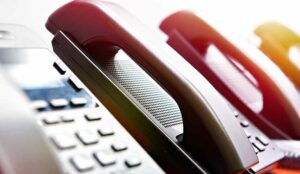Our panel reveals how you can get the best out of your existing outbound dialler.

Chris Key
Present local numbers to improve answer rates
When people don’t recognise the caller’s number, or see a non-geographic number, they’re much less likely to pick up.
Most diallers can set the caller ID to match your prospect’s geographic area – so your callers see a familiar number and are more likely to answer the phone.
With thanks to Chris Key at Hostcomm
Your dialler is only as good as your data
It is possible to invest huge amounts of money in your outbound dialler, with many manufacturers, options, features and configurations to choose from.
But a call centre can have the most sophisticated dialling configuration in the world and still get a poor return on investment if the call data is not solid and reliable.
To get the best out of your outbound dialler, consider each aspect of the campaign. There are various ways in which you can access and refine the best call data available, such as telephone number validation or real-time TPS cleansing. Such procedures allow call centres to maximise the efficiency and productivity of their diallers.
With thanks to Martyn King, Managing Director at Nexbridge
Don’t start the call with an automated message
Don’t start the call with a robot then pass through to a member of the sales team!
While this is useful and saves time for your staff by eliminating those that don’t answer the phone, only a very small percentage of the people you call will stay on the line if they answer the phone and hear an automated message. Instead, make sure the agent is on the other end of the phone when the customer answers, as this will engage the customer straight away.
Regularly update your list of contact details
There is nothing worse for a customer than getting a phone call for someone who had that phone number four years ago, or getting a call from another country at 3am.
It doesn’t do your brand image any good! Make sure you regularly update your lists, time zones, administrator names and contact materials.
[We recently received a phone call for a lady who last lived in our house 12 years ago – Editor]
With thanks to Lucille Needham, Senior Marketing Manager at Genesys
Use ‘progressive dialling’ to remove the risk of silent calls
Using ‘progressive dialling’ rather than ‘predictive dialling’ can remove the risk of silent calls, which are annoying for recipients and can result in big fines and negative publicity for you.
Progressive dialling works by waiting until the agent has indicated that they are ready for a call, so information about the call is presented and the number is then dialled.
Predictive dialling relies on automatically dialling out calls at a rate forecast to match the speed at which agents will be available – but runs the risk of an agent not being available for a call at any time and therefore those ‘silent calls’.
With thanks to Simon Beeching at Syntec
Extend your automation to your CRM
It’s automation that makes an outbound dialler so useful, but you can extend that automation across other areas.
Using an application programming interface (API), the dialler can work closely with your customer relationship management (CRM) platform.
Integrating your dialler and CRM means you could:
- Update client records automatically when calls are made
- Provide agents with up-to-date information from your CRM
- Automate follow-up and administration – like changing customer status or despatching more information by post or email
Automation can also be extended to other areas, such as the central calendar system, emails, appointment reminders, inbound email, and SMS messaging.
Use scripting to improve customer service
A dialler can provide an application programming interface (API), giving you the freedom to use logic-based scripting.
It’s a way to provide a clear, easy-to-follow template for calls, which can ‘pop’ to the agent, and shows relevant screens depending on how the call progresses. Once a call is completed, the information collected on every screen is saved to the database.
As a result, you can reduce the time you need to spend on training, and give agents confidence – which increases performance.
Find out how your call traffic is routed
The features of a dialler are generally pretty clear, but it’s important to consider the infrastructure that supports your calling.
Pushing high volumes of calls through a single service provider can lead to failed calls – due to limits on calls per second (CPS) and channels available. The result is low call connect rates and less-than-optimal campaign performance.
Intelligently routing traffic to multiple service providers using soft switches can help to overcome this.
When the aggregate CPS limits and total channels available is higher, the network can handle high volumes better – and that has a direct impact on your campaign performance.
A dialler can play a key role in helping you stay PCI compliant
We’re all aware of the rules and regulations around accepting card payments over the phone, but a dialler can play a key role in helping you stay PCI compliant.
Assuming your dialler is on a dedicated, firewalled server with admin logging and a clear audit trail, you can use it to take card payments from your clients. There are several possible methods, including interactive voice response (IVR) payment systems and agent-assisted payments.
When these processes take place on the main dialler server, they’re secure, easy to audit from your main reporting engine, and compliant.
With thanks to Chris Key at Hostcomm
Mobile number screening can filter out any invalid numbers
If your calling lists typically contain higher volumes of mobile numbers then consider using tools such as mobile number screening.
This will filter out any invalid numbers, as well as any mobiles that are turned off or set to roaming, meaning no time is wasted even trying to connect the calls and you can focus only on those good numbers.
Change your campaign hours to fall in line with peak connection times
Consider whether there are changes that you can make to the campaign hours and agents’ shifts to enable the dialling to better fall in line with your peak connection hours.
Do not forget to ask your customers what matters to them; you might want to figure out what time of day your customers prefer to receive telephone updates and call-backs. Use this data wisely to schedule your campaigns and shifts.
Turn on local number presentation
Turn on mobile number presentation and/or local number presentation – instead of presenting a generic 0845 or 0800 number to the dialled party.
By giving the customer a perception of local presence – which many customers like – you’ll also increase answer rates, typically by 20% or more.
It will also increase the rate of ‘call-backs’ and, most importantly, the customers who do call back are five times more likely to convert (be that appointment booking, debt collection or whatever) – primarily because when they do call back they are doing so at a time that suits them, and are therefore more receptive.
Autodialling technology can increase connects by up to 70%
Autodialling technology can increase connects by up to 70% when compared to dialling manually.
The typical talk time – in terms of minutes per hour – increases steadily with more advanced dialling modes; going from an average 12 minutes (20% efficiency) in the hour for manual dialling, up to 18 for preview, 32 for progressive and 45 minutes (75%) when using predictive dialling (sometimes higher).
Monitor your wait time and review your dashboards
Monitor your wait time, and if it’s high then review your dashboards to see if data starvation is the problem.

Mike Donohue
A good predictive dialling system will flag these issues up for you without the need to go wading through vast amounts of data to try and pinpoint where the problems are.
You might consider investigating other avenues for data sourcing but you can also look to do more with what you already have. For example, wrong numbers; it’s a quick win to send these records to a data cleansing company for verification.
With thanks to Mike Donohue, Sales Director at Magnetic North
Adapt your strategy to the people you are targeting
Always think about the people you are targeting:
- Break data into smaller batches of a similar demographic to make targeting data easier.
- Be aware that if you are targeting an elderly demographic, they take longer to get to the phone and will need a longer ring timer.
- Mobile numbers are generally quicker to answer and voicemail kicks in between 19 and 21 seconds so ring times can be shorter.
- Unemployed people are more likely to be home between 9am and 5pm, whereas employed people are more likely to be at work, so target these numbers at given times to optimise connect/right-party contact rates.
Take the time to step back and look at the results of your dialling strategies
Review your strategies:
- Take the time to step back (perhaps every quarter) and look at the results of your dialling strategies so they can be tweaked to improve performance for the future.
- Attend supplier seminars/webinars to mix with your peers and find out how they run their strategies, and learn from best practices.
Set a limit for the number of attempts per record
Don’t churn your data endlessly. Set a limit for the number of attempts per record and stop calling the record when the limit is reached.
This makes sure the penetration rate of your data lists continues as the number of records you are holding continues to grow, while also making sure you are not damaging your reputation by endlessly calling customers (or possible customers) who have previously shown no interest in your product/solution.
With thanks to Sian Ciabattoni at Noble Systems
Maximise the value of your data
It’s not just about calling, it’s about connecting! Integrate with your CRM to maximise the value of the data you hold on your customers and prospects to create a richer dialling experience.
Knowing who you’re calling, their interests and contact preferences, will help ensure you have meaningful conversations.
With thanks to Jonathan Gale at NewVoiceMedia
A properly cleaned database is worth its weight in gold
Clean up your data before using a dialler. You’d be surprised how many contact centres still set the dialler using a dialling list which is full of out-of-date information, errors and duplications. This is guaranteed to waste time, money and annoy customers. It also risks compliance issues.
Going through every entry may seem time consuming and boring but will reap long-term results.
A properly cleaned database is worth its weight in gold – and, once you’ve got it into reasonable shape, keeping it that way afterwards won’t take long.
Precision dialling gives you the optimum chance of making successful calls
It doesn’t matter what dialler you use – if you’re just setting it to call people randomly during operating hours you’re not going to get many live connects.
Precision dialling gives you the optimum chance of making successful calls because it dials:
- At the right time
- In the right place
- With the right message and medium to catch the contact’s attention.
Use stats to find out exactly when peaks and troughs occur during the day
Make good use of your stats! Specific campaigns have completely different connection profiles so there is no general rule for setting diallers.
You need meaningful management data which will show you exactly when peaks and troughs occur during the day. Without it, how would you know that, after a dip, your call rates started to build again at 6pm and so it would be worth staying open for longer and trying those elusive customers then?
Use intelligence to develop individual profiles
To get precision and the most effective campaign outcomes you need to use more intelligence about each individual you’re trying to contact.
Look closely at findings to get a true understanding of what is really causing the pattern of connections: who your contacts are, how old they are, what sorts of issues they might have… you have to know your customers!
You should also put everything into their individual profile and keep adding to it so that you have a good picture of who it is you are calling and when they’re likely to be there to answer.
Don’t ring parents during the school run
If you don’t have much history of the contact – if perhaps you’re cold calling – clichéd thinking can work until you start building your own records. For example, if you know your contact is a parent, don’t bother phoning at school run times.

Ken Reid
If you know they work, phone in the evening. If you know they prefer to be telephoned don’t email them… You should also be able to look at your inbound records to pinpoint the best time to call that person, based on when they call you.
It’s not rocket science but if you use this intelligence when setting the dialler you are much more likely to connect. Not only that, but when you do, a screen pop can provide you with the right customer history so that you will know who you’re talking to and be able to have a confident, successful conversation.
With thanks to Ken Reid at Rostrvm Solutions
Limit RNA to 18 seconds
Ring No Answer (RNA) is the length of time that an outbound call rings before the predictive dialler hangs up with a call disposition of No Answer.
If asked “How should RNA time be set for maximum productivity?” many people would answer “the longer the better”. However, answering patterns in reality (universally and for any industry) show the phenomenon of diminishing returns.
Imagine an insurance salesman knocking on doors. He knows that 9 out of 10 people (if they are home) answer the door within 10 seconds.
If he wants to maximise his productivity for the day, he knows there is no point standing at the door for 30 seconds. After 10 seconds he will try the next house, even though he knows he is turning his back on the occasional elderly person or busy mum who is a little slower than average.
A similar principle (although with more complicated factors) holds true for outbound calling. The question is: how long should you stand at the door?
If you are looking for a live person, then over 95% will have answered within 17-18 seconds. Any RNA time over 20 seconds makes no sense and may actually reduce performance and send your costs up.
Set detailed rules for scheduling calls and retries
Key to high productivity is the ability to schedule a call to be made at (roughly) a particular time of day, taking account of history of contact attempts and other intelligence.
Beware any strategy that says ‘Dial all the numbers, then redial all the no answers, then answer machines…’ There is no scope for intelligent selection of time to call in such a model.
Here’s some common-sense for time-of-day calling:
- A telemarketing operation will get higher connect rates calling home numbers outside of business hours than inside business hours.
- If you call somebody at the same time of day as you did yesterday you’ll likely get the same outcome.
- If you know the called party is present (because the line is busy), call them again soon.
- If you said you’d call somebody at a particular time of day, you get best results by honouring your promises.

Jamie Stewart
By scheduling retries for a particular time of day you get significant improvement in connect rates for retried calls.
By making intelligent decisions on whether a lead is ‘spent’ you can avoid ‘flogging a dead horse’-type dialling. Your retry scheme should give you several ways to determine whether or not it is worth retrying the customer.
Lastly, by skewing the time-of-day rules for calling home numbers, work numbers and mobiles it is possible to even out connect rates throughout the call centre shift, leading to better overall performance.
With thanks to Jamie Stewart, Marketing Manager at Sytel Limited
Integrate it into a multimedia approach
Organisations are increasingly building social media into their platforms and integrating this into their other forms of communication – including voice.
While voice is the most personal way to speak to a customer, it should never be the only form of outbound communications that you use.
Therefore the first priority for any outbound dialler is to ensure that it is integrated within a multimedia solution.
In addition, whenever an agent is making an outbound call, they should be able to see all of the communication that their colleagues have had with that same customer – irrespective of whether this was over the phone, email, social media or even video.
Pre-communication will improve rapport with the customer

Stephen Wright
Don’t just hammer the phones all day. By the time you call the customer they should have already been contacted by your organisation on more than one occasion and via a number of different methods.
Using multiple contact points is necessary as the customer is unlikely to receive every single message. This pre-communication will also improve rapport with the customer so that they are more receptive to taking the call when it happens.
With thanks to Stephen Wright at Azzurri Communications
What methods do you use to get the best out of your outbound dialler?
Author: Megan Jones
Published On: 27th Aug 2014 - Last modified: 12th Nov 2024
Read more about - Technology, Dialler, Genesys, Hostcomm, Intrado, Jonathan Gale, Ken Reid, Maintel, Nexbridge, Noble Systems, Outbound dialling, Rostrvm, Syntec, Sytel, Vonage








































